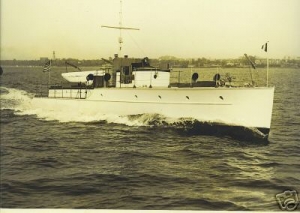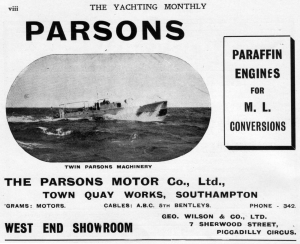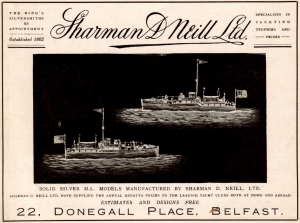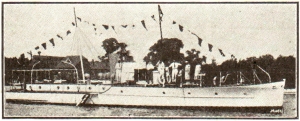The Motor Launch as Pleasure Yacht
As quickly as the force of the Motor Launch Patrol was built-up, at war's end it was torn down. At least a few of the ML's still under construction at the Elco facilities were sold to private buyers and converted to pleasure yachts by Elco.
As quickly as the force of the Motor Launch Patrol was built-up, at war's end it was torn down. At least a few of the ML's still under construction at the Elco facilities were sold to private buyers and converted to pleasure yachts by Elco.
Christian Brann notes on the Association of Dunkirk Little Ships site "Fortunately, so popular and reasonably priced by the Admiralty were these surplus boats that the weekly 'Motor Ship and Motor Boat' ran extensive articles thoughout July 1919 on the best ways of converting them to motor yachts in every detail 'to allow comfortable cruising at moderate cost'." And at the price the ML may indeed have been a good deal - anywhere from £100 to £600 - quite a deal considering they originally cost the government at least £8400!
Articles and advertising appeared in magazines such as The Motor Ship and Motor Boat and The Yachting Monthly throughout much of the early 1920's targeting the new civilian ML owners hoping to convert them from their spartan military configurations to more luxurious accomodations. How-to articles showing interior modification ideas as well as ways to change or upgrade the ship's systems to more suitable civilian uses were common. Advertisers included manufacturers of engines (the Standard engines were probably not well suited to civilian life without dedicated motor mechanics to baby them). Other advertising was probably aimed at the nostalgic former ML commander, with products such as ML-related jewelery and models.
Articles and advertising appeared in magazines such as The Motor Ship and Motor Boat and The Yachting Monthly throughout much of the early 1920's targeting the new civilian ML owners hoping to convert them from their spartan military configurations to more luxurious accomodations. How-to articles showing interior modification ideas as well as ways to change or upgrade the ship's systems to more suitable civilian uses were common. Advertisers included manufacturers of engines (the Standard engines were probably not well suited to civilian life without dedicated motor mechanics to baby them). Other advertising was probably aimed at the nostalgic former ML commander, with products such as ML-related jewelery and models.
It's also possible that an ML or two already on the ways in the Canadian shops at the end of the war may have ended up as yacht conversions. Elco historian William Swanson notes in a fairly recent article in WoodenBoat Magazine, The Elco Motoryachts:
"...after the war, Elco built two very large power cruisers based on their WWI work. The first of these was Hull No. 1616, an 80' motoryacht based on the 80' ML hull. Whether 1616 was a leftover ML or was new construction purpose-built for customer Chester W. Chryson is not known, but the odds greatly favor the first idea. Chryson named his yacht NIAGA."
WoodenBoat No. 171, March/April, 2003
Dick Durham relates in The Magician of the Swatchways, his biography of Maurice Griffiths long-time editor of The Yachting Monthly, that he and his wife Peter Gerard lived aboard one of the 80 foot ML's, christened Night Mist, in the late 1920's. Griffiths is quoted as noting "She was in a fairly ropey condition." Clearly, not every ML enjoyed lavish attention. An ironic choice given the staunch anti-ML stance of the magazine's editorial staff during the war.
Here's an advertisement from The Yachting Monthly in 1922 for an M.L. conversion:
Here's an advertisement from The Yachting Monthly in 1922 for an M.L. conversion:
For Sale. - Motor Yacht (ex-M.L.), recently reconstructed; highest possible condition; electric light, bathroom (h. and c.), saloon (can dine 8 comfortably), and 2 large double-bedded cabins; lofty and well ventilated; New Twin Motors, speed up to 14 knots.
One of the first batch of 50 ML's showed up on the pages of The Yachting Monthly in 1925 accompanied by a picture of a considerably modified ship:
"75-ft. Twin Screw Motor Yacht. Two saloons, one mahogany panelled, other convertible double cabin, making 3 double, 1 single, large light staterooms, ex-saloon and f'c'le'; galley 12 ft. x 5 ft. Spring mattresses, carpets, cushions, curtains, etc. Schooner rigged, with funnel on fidlay, teak skylights and fittings. Two 60 h.p. Parsons' paraffin engines, giving 11 knots, 3 gallons per hour per engine at 8 knots. In full commission. Seen Thames. Open to any survey. Just returned cruise Holland. Splendid seaboat. Smart appearance. £1,500. Deferred payments arranged or exchange steam yacht."
A funnel! and schooner-rigged!! It would be fascinating to find an account of their cruise in Holland.
And again, from the same magazine in 1929:
And again, from the same magazine in 1929:
For Sale - 80 ft. M.L., converted to yacht. Three single, two double cabins, spring berths; saloon, 10 ft. headroom. Electric lighting set, navigation and search lights. 90 h.p. paraffin motor, speed about 7 knots. Full inventory, furniture, cruising gear. Used as houseboat during winter, East Coast. Price, with bath, morrings, gangway to private path, £400.
Richard Taylor, writing for the Naval Historical Collectors & Research Association in the article Wooden Hulls and Cast Iron Stomachs, The Royal Navy's Motor Launches in WW1 , notes
"After the end of the war, surviving M.L.s were sold off, mostly in large lots and at bargain prices. By 1924 only eight remained in service and the last of these had gone by 1927. M.L. 381 saw out the war and was almost certainly one of those that was sold. Her eventual fate is not known but many launches continued to do duty as houseboats. Is it possible that she or any of her ageing wooden-built sisters might still be found moored somewhere in an estuary or by a river bank?"
Yes indeed, at least one ML still exists (somewhat) today!



